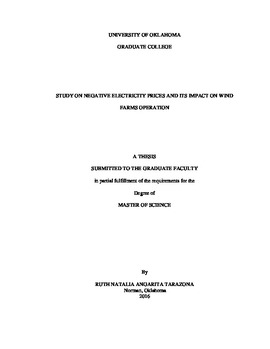| dc.description.abstract | The relation between Negative Electricity Prices (NEPs) and Wind Power Producers (WPPs) in the wholesale market, shows the complex paradox of the integration of wind power, and renewable energy in general, in the day to day power system operation. The occurrence of negative prices is an intended price signal to inform the generation to reduce its output level, or the cost to be charged to wind generation for congestion management. Thanks to the intermittency of the wind and the encouragement of the government in the form of a Production Tax Credit (PTC) to produce wherever there is wind; WPPs often found themselves bidding and generating at negative prices. However, negative electricity prices are not reflecting that there is something wrong with wind power or the system per se, they reflect that wind power and other renewable technologies have new and unforeseen characteristics that are challenging the status quo of the system. There is no doubt that the power sales and distribution system must adapt, however, the complete restructuration of the power system would take decades, which sharply collides with the fast-growing government encourage integration and investment on renewable energy.
Wind farms in the US could possibility take advantage of this situation, given that new alternatives to the current bid and operational strategy of WPPs have emerged. The introduction of the Investment Tax Credit (ITC), a federal incentive that is not tied to the amount of power generated by the wind farms allows wind farms to explore different alternatives to maximize their sales revenue. Additionally, the fact that new wind plants have more control to limit ramp rates and its output, make it possible for wind farms to implement predictive control avoiding then to generate at negative electricity prices. In this thesis, a number of studies are conducted to investigate the nature of negative electricity price drivers since NEPs are a fairly new phenomenon and this is crucial information to effectively forecast them and migrate them; and to examine the economic feasibility of predictive control for WPPs receiving ITC subsidy. The studies evaluate the current impact of negative electricity prices on WPPs’ sales revenue to further back up predictive control (curtailment at negative electricity prices) as an economic sound alternative for WPPs receiving ITC subsidy. Moreover, a fairly simple three steps discrete approach is proposed. The main aim of the proposed approach is to capture the nature of the negative price drivers through its influence in the negative prices’ behavior. Last of all, the economic value of appropriately represent the nature of negative electricity price drivers for a wind farm is studied.
The results of the study suggest that given the current market structure, the negative price drivers show indication of being of a discrete kind. Furthermore, this finding has a positive impact on the sales revenue of a wind farms, as it helps to better describe and predict negative prices. Summarizing, results are promising towards a predictive control as a feasible- economic sound alternative for WPPs receiving ITC subsidy. Potentially, these findings could lead to a proper forecast of negative electricity prices that considers important characteristics like the nature of their drivers; that can be used by WPPs receiving ITC subsidy to apply predictive control. Predictive control would directly economically benefit wind farms, and indirectly improve system stability by reducing the occurrence of negative electricity prices by decreasing the number of wind farms that bid and generate at negative electricity prices. | en_US |
